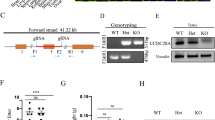Abstract
Samples of males reveal the presence of a large, mitotically stable supernumerary chromosome in five populations examined. A stable frequency (11.22±0.3%) of male carriers has been observed over nine years in one population. The supernumerary follows closely the condensation cycle and behaviour of the sex chromosome in spermatogonial mitosis and meiosis. A structure simulating a terminalized chiasma frequently joins the precocious sex and supernumerary chromosomes during meiotic prophase; these two chromosomes move preferentially (70%) to opposite poles during the subsequent stages producing a differential transmission of the supernumerary to the two sexes. It is possible that the stable frequency in the population is maintained by a conserved balance between the two sexes without the need of an elimination system. The evidence supports the interpretation that the supernumerary chromosome is partially homologous with the sex chromosome. The possibility that the supernumerary might evolve into a neo-Y chromosome is suggested.
Similar content being viewed by others
References
Bosemark, N. O.: On accessory chromosomes in Festuca pratensis. V. Influence of accessory chromosomes on fertility and vegetative development. Hereditas (Lund) 43, 211–235 (1957).
Frost, S.: Studies of the genetical effects of accessory chromosomes in Centauria scabiosa. Hereditas (Lund) 44, 112–122 (1958).
Kimura, M., and H. Kayano: The maintenance of supernumerary chromosomes in wild populations of Lilium callosum by preferential segregation. Genetics 46, 1699–1712 (1961).
Müntzing, A.: A new category of chromosomes. Proc. Xth Internat. Congr. Genet., vol. 1, p. 453–467 (1959).
Nur, U.: A supernumerary chromosome with an accumulation mechanism in the lecanoid genetic system. Chromosoma (Berl.) 13, 249–271 (1962a); - Population studies on supernumerary chromosomes in a mealy bug. Genetics 47, 1679–1690 (1962b); - A mitotically unstable supernumerary chromosome with an accumulation mechanism in a grasshopper. Chromosoma (Berl.) 14, 407–422 (1963); — Harmful supernumerary chromosomes in a mealy bug population. Genetics 54, 1225–1238 (1966a); - The effect of supernumerary chromosomes on the development of mealy bugs. Genetics 54, 1239–1249 (1966b).
Ohno, S., W. D. Kaplan, and R. Kinosita: On the end-to-end association of the X and Y chromosomes of Mus musculus. Exp. Cell Res. 18, 282–290 (1959).
Roberts, R. R. A comparative study of the subfamilies of the Acrididae (Orth optera) primarily on the basis of their phallic structures. Proc. Acad. Nat. Sci. Philad. 92, 201–246 (1941).
Rutishauser, A.: Genetics of fragment chromosomes in Trillium grandiflorum. Heredity 10, 195–204 (1956).
Sharman, G. B.: The cytology of Tasmanian short-horned grasshoppers (Orthoptera Acridoidea). Pap. and Proc. Roy. Soc. Tas. 86, 107–123 (1952).
White, M. J. D.: Cytogenetics of orthopteroid insects. Advanc. Genet. 4, 267–330 (1951); - Animal cytology and evolution, 2nd ed. Cambridge: Cambridge University Press (1954).
Author information
Authors and Affiliations
Rights and permissions
About this article
Cite this article
Jackson, W.D., Cheung, D.S.M. Distortional meiotic segregation of a supernumerary chromosome producing differential frequencies in the sexes in the short-horned grasshopper Phaulacridium vittatum . Chromosoma 23, 24–37 (1967). https://doi.org/10.1007/BF00293310
Received:
Issue Date:
DOI: https://doi.org/10.1007/BF00293310




